I have a beautiful feijoa tree in my backyard that’s likely 30 (or more) years old, and every spring it blossoms with clusters of small (and amazingly sweet) pink and white edible flowers. In the summer these flowers turn into dull green, egg-shaped and egg-sized fruits called feijoas (Acca sellowiana).
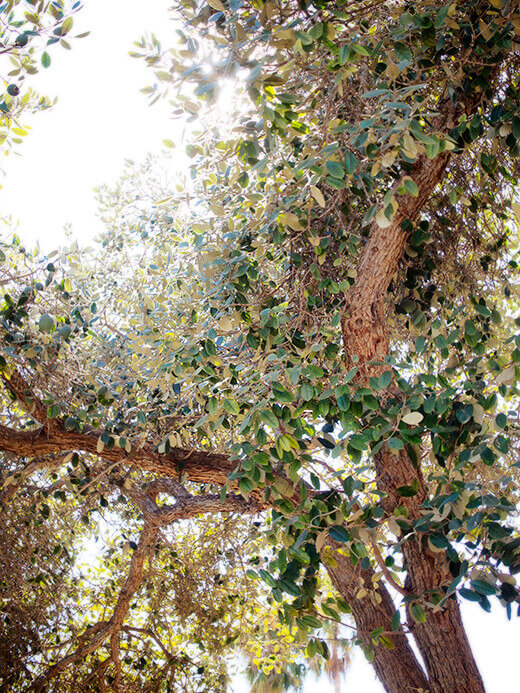
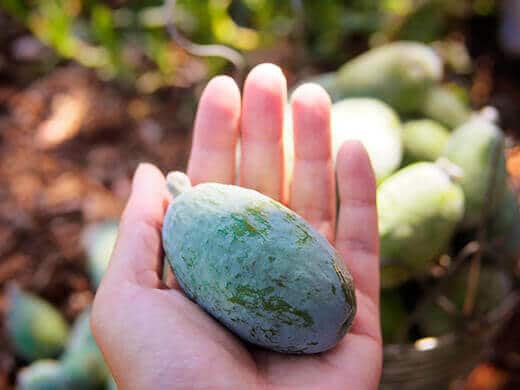
They’re native to Brazil and were named after a Portuguese (but Brazilian-born) botanist, João da Silva Feijó. (And apparently, I’ve been saying the name wrong these last couple of years. The Brazilian name, feijoa, is pronounced fay-ZHOE-uh, where the “zh” sounds like the “s” in pleasure.)
I don’t see very many feijoa trees (or fruits, for that matter) in California, though it’s a popular and prolific garden plant in New Zealand where the fruit is widely available. It’s also known as pineapple-guava or guavasteen, and a bite into the flesh reminds me of pineapple, guava, and a bit of pear, because the flesh near the skin is slightly gritty.
Though it seems like you can find feijoas anywhere in New Zealand (and people seldom pay for them because they’ll likely have a neighbor giving away armfuls at a time), they’re less common in California. If you can find a farmers’ market that carries them, they command a pretty penny… and that little fact makes me chuckle, because from September through November, my feijoa tree drops buckets upon buckets of fruit. Buckets! (This is just from the morning harvest… which means that later in the day, when I head back outside to harvest things for dinner, I’ll find another bucket’s worth waiting on the ground for me.)
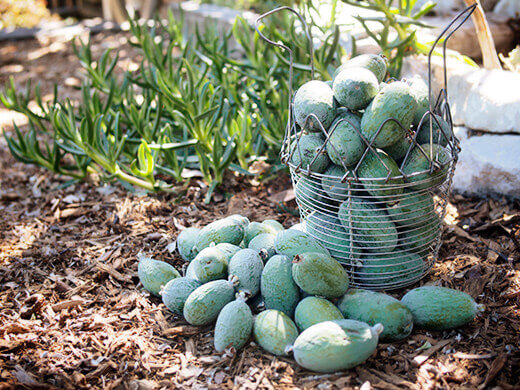

It’s impossible to keep up with and last year I composted half of my harvest… after eating, canning, cooking and giving away what seemed like hundreds of pounds of fruit. Granted, the half that I did compost were mostly bruised or half-eaten by squirrels; feijoas drop to the ground once they’re ripe, and they tend to have delicate skin despite feeling rock hard.
This year, as feijoa season is starting with a vengeance, I’m determined to put as many of the fruits to use as possible. Eating one or two a day just isn’t going to cut it. I need to plow through pounds and pounds of this stuff, and for those of you drowning under feijoa trees in your own backyard, this will be the first in a three-part series. Over the next couple of weeks, I’ll present to you Feijoa 3 Ways: three easy recipes for taking those fruits deliciously down.
My first, feijoa salsa, is so simple that I wonder why I didn’t make it sooner. It’s fresh and zesty, and makes a great dip for chips but an even better topping for fish (whether you like it steamed, grilled or fried, by itself or in a taco).
I use Vietnamese perilla (tía tô) as the herb in my salsa, which gives the flavor an incredible, fragrant kick. Perilla is a member of the mint family and most commonly used in Asian cooking. It tastes like a cross between mint and basil. You can find it in any Vietnamese/Chinese market, or in a Japanese market where it’s called shiso. The leaves are green on one side and purple on the other, though some varieties are all green or all purple.
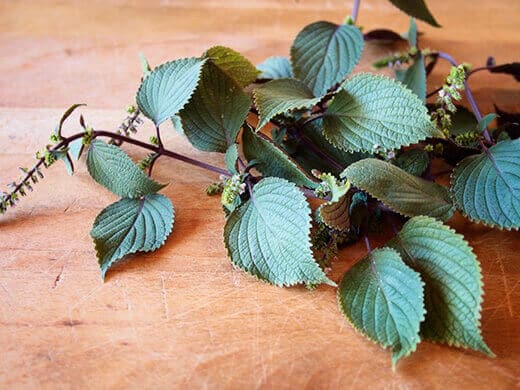
While you’re at the Asian market buying a bundle of perilla, pick up a package of Thai bird’s eye chilies too (it will probably take you a while to go through them, but they freeze very well). These tiny red and green peppers are the fire behind Thai food. If you’re not a fan of spicy salsa, reduce the amount in the recipe to just one chili.
You can also substitute cilantro and jalapeño for these two ingredients, but I highly recommend you try the more “exotic” version if you’re able to source the perilla and chilies!
And by the way, I ended up making 2 jars of this salsa which used up nearly 30 ripe feijoas — or an entire morning’s harvest. Yes! (I’ll be making plenty more. I love this stuff.)
Feijoa Salsa
Makes 1 quart
Ingredients
10 to 15 feijoas, peeled and finely diced
1/2 red onion, diced
2 Thai bird’s eye chiles, minced
2 tablespoons chopped Vietnamese perilla
Juice from 1 lemon
Making Feijoa Salsa
After peeling and dicing the feijoas, you should have 3 to 3 1/2 cups of fruit.
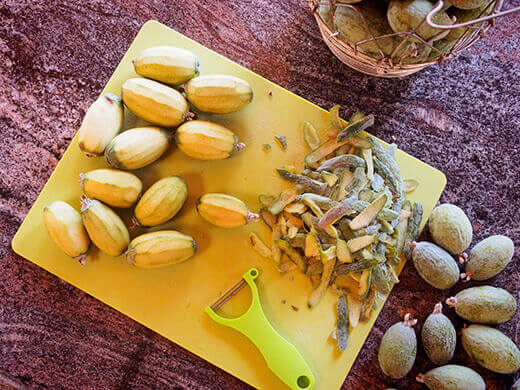
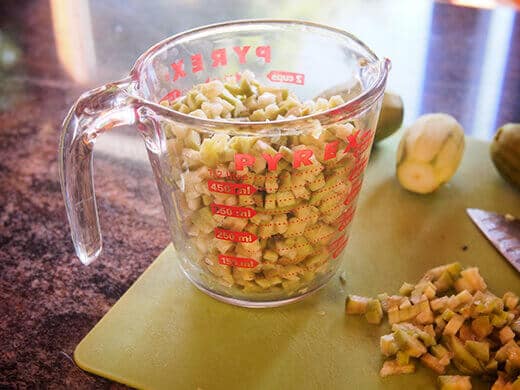
Combine all the ingredients in a medium bowl, then decant into your container of choice (this amount fits perfectly into a quart-sized jar).
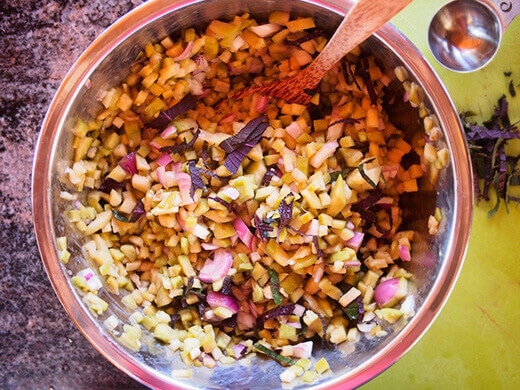
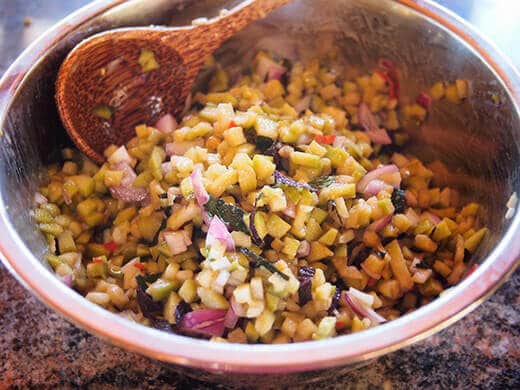
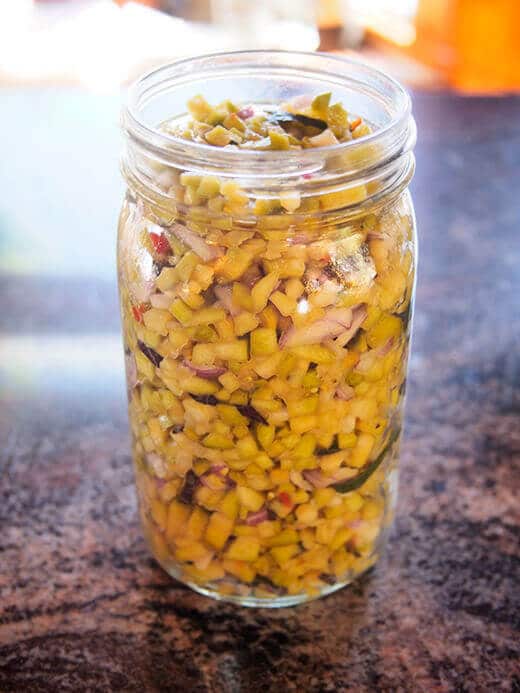
I like to let the salsa sit for a couple of hours to really let the flavors meld together, but you can dig in right away if you wish. The salsa will keep for at least a week or two in the fridge.
Feijoa Salsa
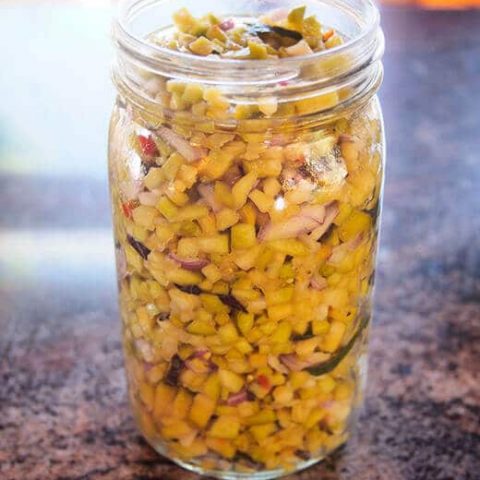
feijoa salsa, is fresh and zesty, and makes a great dip for chips but an even better topping for fish (whether you like it steamed, grilled or fried, by itself or in a taco).
Ingredients
- 10 to 15 feijoas, peeled and finely diced
- 1/2 red onion, diced
- 2 Thai bird’s eye chiles, minced
- 2 tablespoons chopped Vietnamese perilla
- Juice from 1 lemon
Instructions
- After peeling and dicing the feijoas, you should have 3 to 3 1/2 cups of fruit.
- Combine all the ingredients in a medium bowl, then decant into your container of choice (this amount fits perfectly into a quart-sized jar).
- I like to let the salsa sit for a couple of hours to really let the flavors meld together, but you can dig in right away if you wish. The salsa will keep for at least a week or two in the fridge.
Notes
You can also substitute cilantro and jalapeño,, but I highly recommend you try the more “exotic” version if you’re able to source the perilla and chilies!
Recommended Products
As an Amazon Associate and member of other affiliate programs, I earn from qualifying purchases.


















I love your feijoa recipes! Here in NZ we have them growing on almost every street and I am obsessed! Check out my feijoa recipes http://emilypepper.blogspot.co.nz/ my favourite is definitely the ice-cream, I freeze the pulp so we can have this all year round! http://emilypepper.blogspot.co.nz/2011/05/feijoa-ice-cream-and-crumble.html
What a unique recipe and a great way to use natural produce from your backyard! You’d make an incredible Feastly cook – please contact us at info@eatfeastly.com to start hosting and providing dynamic social/food experiences.
Your salsa looks so yummy! In San Diego we have a beautiful, very old feijoa tree — its canopy covers almost our entire back yard. And like yours, it fruits like nobody’s business. Last year we infused them in gin; this year we pickled them with masala.
The gin infusion sounds amazing!
It was! If you wanna check it out, it’s here: http://thehorticult.com/guava-gin-infusion/
What to do with your prolific harvest this fall: Feijoa Three Ways: Feijoa Salsa (Part I) http://t.co/w0MMfNEohY < TY for RT! @jchapstk
Also known as pineapple-guava and tasting exactly like it. Feijoa Three Ways: Feijoa Salsa (Part I) http://t.co/Wh8TIHB4u9 #gardenchat
Got these prolific trees in your backyard? Here’s how to use them: Feijoa Three Ways: Feijoa Salsa (Part I) http://t.co/p2h1J4TtsJ #recipe
These fruits taste like a cross between pineapple, guava and pear. Feijoa Three Ways: Feijoa Salsa (Part I) http://t.co/6r7trOyPhA #recipe
RT @AmyMart435: Abundant in New Zealand, but an exotic treat in California. Feijoa Three Ways: Feijoa Salsa (Part I) http://t.co/oPWaXhLCWK…
Abundant in New Zealand, but an exotic treat in California. Feijoa Three Ways: Feijoa Salsa (Part I) http://t.co/oPWaXhLCWK #recipe
Abundant in New Zealand, but an exotic treat in California. Feijoa Three Ways: Feijoa Salsa (Part I) http://t.co/jneX88jWq7 #recipe
Is Vietnamese perilla the same as or similar to the kind used in Korean cuisine? I love perilla and I’ve never thought of using it in a salsa, what a great idea! I must try this.
Yes, same herb! I think they all vary slightly in flavor, but technically they’re all perilla. I also use them to make pineapple salsa and pineapple salad.
RT @theGardenBetty: What to do with your prolific harvest this fall: Feijoa Three Ways: Feijoa Salsa (Part I) http://t.co/w0MMfNEohY #garde…
What to do with your prolific harvest this fall: Feijoa Three Ways: Feijoa Salsa (Part I) http://t.co/w0MMfNEohY #gardenchat #recipe
I purchased a pretty frazzled pineapple guava from Walmart, of all places!, a year ago. This year it had one blossom on it . . . No fruit yet.
Didn’t know they got so tall, but am looking forward to making jams and salsa in the future! Thanks for the history and recipes!
How random! What city was this?
We live 32 miles west of Phoenix, AZ on 3 irrigated acres. After becoming beekeepers a little over a year ago, I’m always on the lookout for flowering trees, bushes and flowers . . . To keep our bees close to home and away from GMO.
I really enjoy your reading your blog. Your photos are awesome!
So sorry for your lose. We had a young dog bite through 2 layers of chicken wire and kill 3 of our girls about a month ago. I couldn’t sleep for a week, picturing them running for their lives, scared to death! We lost our Americauna, Lucy, Glory, a beautiful speckled Sussex, and Maggy (Big Fatty) our partridge, giant Cochan. They were a huge part of our family! The two who ran and hid, Sophie and Buffy, have lost their joy . . .
I can’t even imagine how hard that must be for you and your flock. The only consolation I had was knowing Gisele died peacefully. We’ve been thinking about adding more hens to our flock in the spring. They’re such social creatures and I’d hate to think how they might feel if we ended up losing another one.
Thanks for the kind words about my blog!
Amber Snow liked this on Facebook.
This sounds delicious. I’m so glad you are providing feijoa recipes. I planted one in my front yard last year but it is still to young to fruit. I’m hoping that maybe next spring it will bloom but I hadn’t seen many recipes for what to do with the fruit. I planted it because it is an attractive evergreen landscaping plant that as a bonus produces tasty fruit.
I love this tree in springtime especially, because the flowers attract birds from everywhere! Our garden is inundated with starlings when the tree is in bloom.
Cary Bradley liked this on Facebook.
Nancy Hanh Thanh liked this on Facebook.
Feijoa Three Ways: Feijoa Salsa (Part I):
I have a beautiful feijoa tree in my backyard that’s likely 30 (or … http://t.co/DlHkAqQQyl
Blogged on Garden Betty: Feijoa Three Ways: Feijoa Salsa (Part I) http://t.co/yqOmr7ztsI